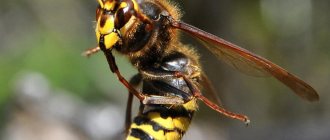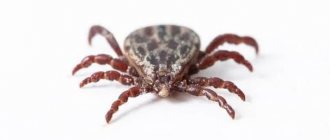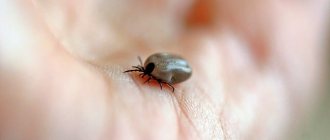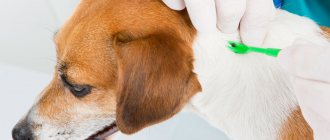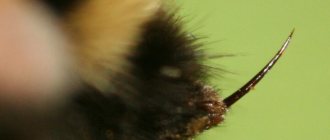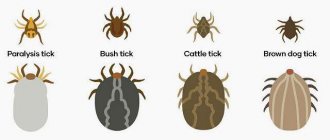The spring period throughout Russia is accompanied not only by the opening of buds and primroses, but also by the appearance of ixodid ticks (Ixodidae, lat.). The “folk” name for these insects is “encephalitis”, although they carry not only this terrible disease.
Ticks begin their activity in early spring, when all the snow cover has not yet melted, and they go into hibernation only in late autumn, with the onset of the first frost. The activity of ticks changes during the warm season, but the likelihood of a bite remains all this time.
The consequences of a dog being bitten by a tick can be negative, but sometimes fatal. The animal may be at risk of contracting piroplasmosis
, which is an infection caused by protozoa of the genus Piroplasma canis. This disease is sometimes also called babesiosis.
Symptoms of infection
If the dog owner has a picture of the disease and is familiar with the symptoms that characterize it, then emergency treatment can be started on time.
Symptoms may include:
- The earliest signs that should alert the owner are lethargy, a significant decrease in activity, loss of the dog’s inherent playfulness, failure to show joy, apathy, lack of desire to go for a walk, etc.;
- Lack of appetite, the dog only drinks, refusing even previously loved treats. Feeding the dog becomes a problem.
This is one of the main signs in the first days of infection; - Subsequently, on the third to fifth day, digestive symptoms become more alarming and obvious - vomiting appears, sometimes with mucus. At the same time, the dog has remained hungry for several days. Diarrhea is possible, the liquid masses of which have a bright yellow or greenish color. Symptoms of diarrhea are not necessary, but the color of the stool definitely changes;
- Stiffness of movement, reluctance to move, shortness of breath, as if every movement brings suffering. The dog tries to find a secluded place and not leave it. Such symptoms already indicate a progressive disease;
- The color of urine is a sign that necessarily accompanies the disease. The urine is much darker
, takes on the color of coffee or dark beer, sometimes even a dark brown color. Pyroplasmas in the blood destroy red blood cells, due to which the color of urine changes. This sign indicates irreversible processes that can lead to death; - Healthy dogs can tolerate the disease almost asymptomatically - the dog dies completely suddenly for its owners, without previously showing any special signs of illness. But the color of urine even in this case is unnatural, which owners should pay attention to;
- Fever;
- The mucous membranes of the eyes turn white.
What can't you do?
Mistakes by the owner when discovering a lump on their pet after a tick bite can seriously harm the animal, and in especially severe cases, cause its death. To avoid harming your dog, do not do the following:
- squeeze out the lump - if suppuration occurs after the bite, then squeezing can cause the infection to enter the blood, resulting in sepsis;
- perform an autopsy of the cone yourself;
- warming up the cone - during a purulent process, this will only worsen the animal’s condition.
When a dog has a lump at the site of a tick bite , you shouldn’t be scared, but you shouldn’t take it lightly either.
What actions to take if your dog is bitten by a tick?
Even if your pet is treated with an anti-tick agent, it is worthwhile to carefully examine the animal after each walk through the forest, grass and bushes. Particular attention should be paid to the following places:
- Ear area;
- head;
- Neck and chest;
- Groin area;
- Front and hind legs.
If you find a tick in your dog's body, you need to remove it as quickly as possible.
. The shorter the period the insect remains in the body, the easier the treatment will be and the more positive the outcome.
Gently palpate your dog:
- The attached insect is detected through the fur - depending on the amount of blood with which the parasite has been fed, it may look like a tubercle the size of a small raisin or a pea;
- Having parted the fur in a suspicious place, you will find a swollen insect;
- If there is a veterinary clinic nearby, it is better to contact it. If you are short on time, you should pull out the tick yourself;
- The most convenient way is to remove it with tweezers. The parasite must be captured as close as possible to the skin where the proboscis entered the body. You need to pull the parasite slowly, holding the animal's skin with your other hand. You can scroll slightly clockwise, but very carefully, because... this can lead to the head of the bloodsucker being torn off. Pet stores sell special tweezers for removing ticks;
- If you don’t have tweezers, pull it out with the same movements using your fingers wrapped in a bandage or napkin;
- Then the wound is lubricated with iodine, brilliant green or hydrogen peroxide.
Treatment of dogs
It happens that the owner, seeing that the pet is unwell, does not go to the clinic, considering this condition to be temporary. As a result, the dog is taken to the hospital in serious condition. For each individual disease, the veterinarian develops an individual treatment regimen. The dog needs anti-parasitic agents and water-soda solutions. A single dose of medication will not be enough. Symptomatic therapy is needed, which can only be prescribed by a specialist. The doctor will describe the exact dosage of medications and the general treatment regimen. A long recovery period will follow.
An approximate picture of home treatment for a mild form of the disease is as follows:
- The use of drugs aimed at destroying the causative agent of the disease with the drugs Pirostop, Berinyl, Imidocarb, Imizol;
- Stimulating the kidneys, alkalizing the urine by introducing sodium bicarbonate and drinking the dog with a soda solution;
- Taking vitamins, glucose and diuretics;
- In severe cases of the disease, a blood transfusion is required;
- The animal must be switched to special food: porridge, vegetables, kefir, special food, meat products.
In many ways, further treatment depends on the dog’s well-being. Already a week after starting to take the drugs, it is necessary to take repeated tests. Based on the results, the subsequent treatment program is adjusted. Veterinarian supervision is necessary for moderate or severe forms of the disease.
Immunity after an illness lasts for a maximum of six months. Then the animal can become infected again with piroplasmosis after being bitten by an infected tick.
The insidiousness of a dangerous disease lies in the fact that no one knows how the unfortunate animal will survive it. In most cases, this depends on the timing of the start of treatment and the dog’s immunity.
Against the background of piroplasmosis, dogs develop numerous complications of the internal organs:
- Kidney and heart failure;
- Damages to the central nervous system and brain function;
- Inflammation of the liver;
- Anemia and arrhythmia;
- Pancreatitis;
- Allergic reactions to various drugs.
In pregnant dogs, the disease is much milder. The fact is that the intrauterine fetus takes the entire blow upon itself. There are cases where pregnant dogs with piroplasmosis have suffered miscarriages. Even after being born, the cubs had a lot of developmental deviations, and later they still died.
The sooner treatment begins, the lower the risk of parasites spreading in the dog’s blood!
First aid after a tick bite
If you cannot quickly seek medical help, then you should try to give your dog 100-150 milliliters of water per hour. If vomiting occurs, give an enema. Subcutaneous injection of a glucose solution of 20 milliliters and vitamins B6 and B12, one ampoule daily, can help.
If you notice clearly defined symptoms of infection, and there is no help to come from, then give injections of Veriben or Azidine solutions (1 milliliter per 20 kilograms of the dog’s weight).
Fighting infection at home is extremely difficult. The specialists of the Aibolit Plus clinic are professionals
who will make every effort to treat and save your pet.
The process of a tick attack on a dog
Hungry ticks find their prey thanks to the presence of special thermal sensors. A dog passing by a bush or grass on which a tick is sitting becomes an object of attack, the tick makes a jump and, clinging to the hair, remains on the dog. Having latched onto a dog, the tick begins to look for the place on the dog’s body that is least covered with hair (skin around the ears, neck, legs, abdominal area, etc.). Further digging into the skin with its tentacles, the tick pierces the skin and begins the process of sucking blood. It becomes almost impossible to tear it away from the dog at this time, and only after the tick has completely drunk blood does it fall off the dog’s skin.
Tick-borne and other types of encephalitis - causes
Tick-borne encephalitis is transmitted by the ixoid tick; the insect injects the virus into the animal’s blood when it bites. Infection can also occur in the presence of a secondary source of infection, during blood sepsis, or as a result of a long-term presence of a foreign body in the body. In all cases, the pathogen is carried through the bloodstream into the brain and/or spinal cord, causing inflammation or infection of the meningeal membranes.
The following dog breeds are most prone to infection:
- pets under 2 years of age with weak immunity;
- elderly animals over 8 years old;
- small breed dogs: decorative terriers, poodles, German shorthaired pointers, pugs, Maltese dogs, beagles;
- all pets who have suffered a traumatic brain injury.
If a dog is at risk, it should be shown to a doctor periodically. Timely treatment increases the chances of recovery and provides a favorable prognosis.
Can babesiosis be transmitted to other animals or humans?
A tick that has drunk blood increases in size a hundred times. It falls off, falls to the ground and, after the eggs mature, dies. The tick cannot attack another victim again.
Babesia do not live in the human body, but arthropods carry pathogens of other dangerous diseases. When a person accidentally crushes a tick, he needs to immediately wash his hands.
If there is a scratch on the skin or your hands touch your eyes, you may become infected with encephalitis, borreliosis, anaplasmosis, or Crimean hemorrhagic fever.
We recommend reading:
- The best flea and tick drops for dogs
- Removing fleas from dogs, what to choose?
Why might a lump appear?
If after removing the tick the dog is left with a small lump, this is the body’s natural reaction to a foreign body. The reasons for the appearance of a lump after an insect bite are:
- Allergy.
When the parasite bites through the skin and attaches itself, it immediately injects saliva into the wound. Often it is the local allergic reaction that occurs to the secreted secretion of saliva that is the cause of the appearance of the tumor. As a rule, this is a small tumor and does not cause any particular problems. The dog's behavior does not change, and there are no health problems. The structure of the neoplasm is dense and hard, the tumor turns red and itches. The fur in this area may bristle, fall out, or change color. - Intoxication of the body.
If the insect was removed incorrectly, particles of the parasite may remain in the animal's body: paws or head. Then an inflammatory process begins at the site of the wound, which leads to the appearance of a neoplasm or even suppuration. The tumor appears within a few days after the bite, gradually grows and significantly increases in size. If suppuration appears, the formation turns red and becomes quite large in size - about the size of a walnut. Touching it is painful, the animal behaves restlessly. - Infection.
Sometimes the dog itself introduces the infection by scratching the damaged area. In severe situations, this is fraught with the development of an abscess, which requires surgical intervention. The lump becomes red in color, increases significantly in size and causes pain in the animal. Symptoms of this condition are fever, lethargy and decreased activity of the dog, and loss of appetite.
Most often, a lump in a dog at the site of a tick bite is caused by a common allergic reaction; less often, it is the cause of infection. But if a loving owner has doubts, it is necessary to show the pet to a doctor.
Stages of disease development
The most common places of bites
Dogs get sick after being bitten by an ixodid tick. Arthropods live on low bushes, sense the approach of prey by air vibrations, heat, and carbon dioxide released during respiration.
In order for the eggs to mature, the female must receive complete protein. The arthropod jumps on the dog, travels around it, finds a secluded place, attaches to the skin, pierces it, and finds a capillary.
Ticks love the ears. To prevent the animal from worrying, the parasite injects an anesthetic and an anticoagulant to prevent blood clotting.
How does infection occur?
Ticks become active in early spring and pose a threat to pets and humans throughout the warm season. During frosts and droughts, parasites do not attack. The tick sucks out the first portion of blood and sends it to the intestines.
Food stimulates appetite and stimulates salivation. Along with saliva, pathogens enter the mammal's bloodstream. Babesia live in adult ticks and do not harm them.
The parasite penetrates the red blood cell. Immune cells - macrophages, absorb infected red cells, but do not kill piroplasms, spreading them throughout the body. A day passes from the moment the tick attaches to the invasion. If during this time the owner is able to remove the arthropod from the skin, infection will not occur.
Incubation period
It takes from 2 to 14 days from Babesia entering the bloodstream to the appearance of painful signs. The duration of the incubation period depends on the strength of the immune system and the number of attached ticks.
Painful symptoms appear when the number of Babesia reaches a critical level. When a protozoan parasite emerges from a destroyed red blood cell, toxic waste products are released into the blood.
Piroplasmosis in dogs. Symptoms and signs
In the fulminant form of the disease, the dog dies suddenly, before symptoms appear. An acute course develops in young purebred animals.
The chronic form occurs in dogs that become ill again, mongrel pets or mixed breeds. Dogs vaccinated against piroplasmosis get sick, but in a mild form.
In acute form
An infected dog develops the following pathological symptoms:
- The animal looks depressed and lethargic;
- the pet refuses food;
- the mucous membranes first turn pale, then turn yellow;
- the temperature rises to 42 °C, hence the name of the pathogen: “pyroplasma”;
- pulse quickens;
- shortness of breath develops;
- urine becomes brown;
- Digestion is upset: vomiting and diarrhea occur;
- paralysis of the hind limbs develops.
These signs of the disease do not appear in all cases, but if at least some are detected, the dog owner needs to go to the clinic.
In chronic form
With the permanent form, the temperature fluctuates: the heat persists for several days and recedes. The pet diarrhea, loses weight, and gets tired quickly. The animal is capricious, its mood often changes, and the symptoms of anemia increase.
The dog recovers, but not completely; it develops chronic diseases of the internal organs.
Characteristics of the disease and its danger
Piroplasmosis in dogs, signs and treatment
Babesia enter the bloodstream, penetrate red blood cells, feed on the contents of the cell, and multiply. Severe anemia develops. The waste products of the parasite affect internal organs.
The functioning of the liver, kidneys, and pancreas is disrupted, and pulmonary edema develops. If the dog is not treated, it will die. Young purebred animals are most seriously ill. Adults and mongrel dogs tolerate the disease relatively easily.
What to feed a dog after piroplasmosis
You should not force feed a sick dog. With natural nutrition, the menu is drawn up together with a veterinarian. The basis of the diet is puree with pureed meat and porridge. Dry veterinary food for dogs with kidney or liver diseases has the best therapeutic effect.
In the first days, if there is poor appetite, the granules are soaked and given several times a day in small portions. After recovery, the veterinarian evaluates the animal’s condition and recommends remaining on medical nutrition or switching to a regular diet.

